ICSE Physics Previous Year Question Paper 2014 Solved for Class 10
ICSE Paper 2014
Physics
(Two hours)
Answers to this Paper must he written on the paper provided separately.
You will not be allowed to write during the first 15 minutes.
This time is to he spent in reading the question paper.
The time given at the head of this Paper is the time allowed for writing the answers.
Section I is compulsory. Attempt any four questions from Section II.
The intended marks for questions or parts of questions are given in brackets [ ].
SECTION-I (40 Marks)
Attempt all questions from this Section
Question 1:
(a) A force is applied on (i) a non-rigid body and (ii) a rigid body. How does the effect of the force differ in the above two cases ? [2]
(b) A metallic ball is hanging by a string from a fixed support. Draw a neat labelled diagram showing the forces acting on the bail and the string. [2]
(c) (i) What is the weight of a body placed at the centre of the earth ?
(ii) What is the principle of an ideal machine ? [2]
(d) Is it possible to have an accelerated motion with a constant speed ? Explain. [2]
(e) (i) When does a force do work ?
(ii) What is the work done by the moon when it revolves around the earth ? [2]
Answer:
(a) A force when applied on a rigid object does not change the inter-spacing between its constituent particles and therefore it does not change the dimensions of the object, but causes motion in it. On the other hand, a force when applied on a non-rigid object, change the inter-spacing between its constituent particles and therefore cause a change in its dimensions.
(b)
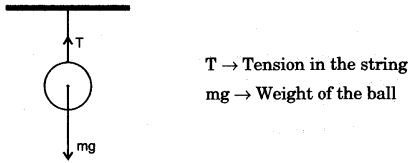
(c) (i) The weight of a body placed at the centre of the earth is zero.
(ii) An ideal machine is that in which there is no dissipation of energy in any manner. The work output is equal to the work input i.e., 100% efficiency.
(d) Yes. The velocity of particle in circular motion is variable or the circular motion is accelerated even though the speed of particle is uniform.
(e) (i) Work is said to be done only when the force applied on a body makes the body moves (i.e., there is displacement of the body).
(ii) The work done by the moon when it revolves around the earth is zero.
Question 2:
(a) Calculate the change in the Kinetic energy of a moving body if its velocity is reduced to 113rd of the initial velocity. [2]
(b) State the energy changes in the following devices while in use:
(i) A loud speaker.
(ii) A glowing electric bulb. [2]
(c) (i) What is nuclear energy ?
(ii) Name the process used for producing electricity using nuclear energy. [2]
(d) State one important advantage and disadvantage each, of using nuclear energy for producing electricity. [2]
(e) (i) The conversion of part of the energy into an undesirable form is called ………. .
(ii) For a given height h, ………… the length l of the inclined plane, lesser will be the effort required. [2]
Answer:
(a)

(b) (i) Electrical energy converted to sound energy.
(ii) Electrical energy converted to light and heat energy.
(c) (i) In nuclear fission and fusion there is a loss in mass due to loss in mass energy is released. The energy so released is called the nuclear energy.
(ii) Nuclear fission.
(d) Advantage: A very small amount of nuclear fuel can produce a tremendous amount of electricity energy.
Disadvantage: Very harmful nuclear radiations are produced in the process which are highly energetic and penetrating.
(e) (i) Dissipation of energy. (ii) More.
Question 3:
(a) Draw the diagram given below and clearly show the path taken by the emergent ray. [2]
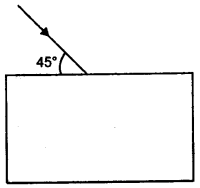
(b) (i) What is consumed using different electrical appliances, for which electricity bills are paid ?
(ii) Name a common device that uses electromagnets. [2]
(c) (i) A ray of light passes from water to air. How does the speed of light change ?
(ii) Which colour of light travels fastest in any medium except air ? [2]
(d) Name the factors affecting the critical angle for the pair of media. [2]
(e) (i) Name a prism required for obtaining a spectrum of Ultraviolet light.
(ii) Name the radiations which can be detected by a thermopile. [2]
Answer:
(a)
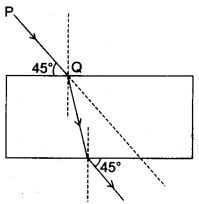
(b) (i) Electrical energy.
(ii) Electrical bell.
(c) (i) Light travels denser to rarer, speed of light increases.
(ii) Red colour of light travels fastest in any medium except air.
(d) Factors affecting the critical angle for the pair of media are :
(i) Effect of colour and
(ii) Effect of temperature.
(e) (i) Quartz prism.
(ii) Infrared radiations can be detected by thermopile.
Question 4:
(a) Why is the colour red used as a sign of danger ? [2]
(b) (i) What are mechanical waves ?
(ii) Name one property of waves that do not change when the wave passes from one medium to another. [2]
(c) Find the equivalent resistance between points A and B. [2]

(d) 50g of metal piece at 27 °C requires 2400 J of heat energy so as to attain a temperature of 327 °C. Calculate the specific heat capacity of the metal. [2]
(e) An electron emitter must have ……….. work function and ………… melting point. [2]
Answer:
(a) Since the wavelength of red colour is maximum in the visible light, the light of red colour is scattered least by the air molecules of the atmosphere and therefore it can reach to a longer distance.
(b) (i) The sound waves require a medium for their propagation. These waves travel in the medium though the vibrations of the medium particles about their mean positions, so they are also called elastic or mechanical waves.
(ii) Frequency.
(c)
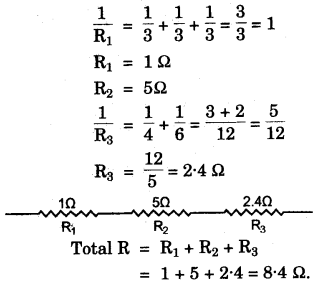
(d)

(e) An electron emitter must have low work function and high melting point.
SECTION-II (40 Marks)
Attempt any four questions from this Section.
Question 5:
(a) (i) A man having a box on his head, climbs up a slope and another man having an identical box walks the same distance on a levelled road. Who does more work against the force of gravity and why ?
(ii) Two forces each of 5N act vertically upwards and downwards respectively on the two ends of a uniform metre rule which is placed at its mid-point as shown in the diagram. Determine the magnitude of the resultant moment of these forces about the midpoint. [4]

(b) (i) A body is thrown vertically upwards. Its velocity keeps on decreasing. What happens to its kinetic energy as its velocity becomes zero ?
(ii) Draw a diagram to show how a single pulley can be used so as to have its ideal M.A = 2. [3]
(c) Derive a relationship between mechanical advantages, velocity ratio and efficiency of a machine. [3]
Answer:
(a) (i) Man climbs up a slope does more work because the work done by the man walking on a levelled road is zero.
(ii)

(b) (i) When a body thrown vertically upward its velocity continuously decreases, kinetic energy also decreases and potential energy increases due to increase in height.
(ii) Single Movable Pulley
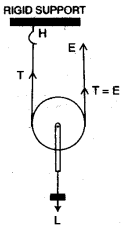
(c) Let a machine overcome a load L by the application of an effort E. In time t, let the displacement of effort be dE and the displacement of load be dL.
Thus, the mechanical advantage of a machine is equal to the product of its efficiency and Velocity Ratio.
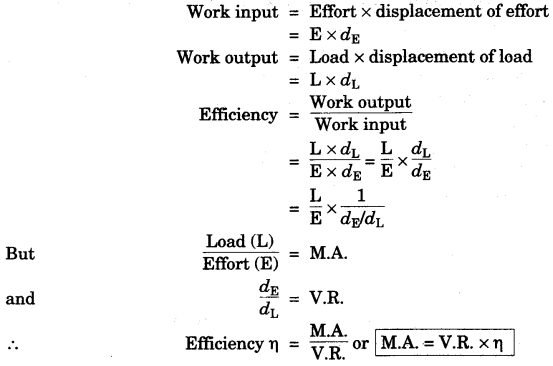
Question 6:
(a) (i) Light passes through a rectangular glass slab and through a triangular glass prism. In what way does the direction of the two emergent beams differ and why ?
(ii) Ranbir claims to have obtained an image twice the size of the object with a concave lens. Is he correct ? Give a reason for your answer. [4]
(b) A lens forms an erect, magnified and virtual image of an object.
(i) Name the lens.
(ii) Draw a labelled ray diagram to show the image formation. [3]
(c) (i) Define the power of a lens.
(ii) The lens mentioned in 6(b) above is of focal length 25 cm. Calculate the power of the lens. [3]
Answer:
(a) (i) In a rectangular glass slab, the emergent ray is parallel to the incident ray hut they are not along the same line whereas in a prism the emergent ray is not parallel to incident ray.
Because in a glass block the two surfaces at which refraction occurs is parallel to each other.
(ii) No. By the concave lens only small size upright images obtained.
(b) (i) Convex lens.
(ii)
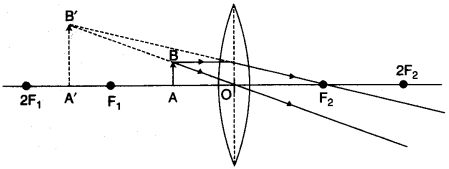
(c) (i) The power of a lens is a measure of deviation produced by it in the path of rays refracted through it.
(ii)

Question 7:
(a) The adjacent diagram shows three different modes of vibrations P, Q and R of the same string.

(i) Which vibrations will produce a louder sound and why ?
(ii) The sound of which string will have maximum shrillness ?
(iii) State the ratio of wavelengths of P and R. [4]
(b) A type of electromagnetic wave has wavelength 50 Å.
(i) Name the wave.
(ii) What is the speed of the wave in vacuum ?
(iii) State one use of this type of wave. [3]
(c) (i) State one important property of waves used for echo depth sounding.
(ii) A radar sends a signal to an aircraft at a distance of 30 km away and receives it back after 2 x 10-4 second. What is the speed of the signal ? [4]
Answer:
(a) (i) R will produce louder sound because its amplitude is more than P and Q.
(ii) The sound of P string will have maximum shrillness.
(iii) The ratio of wavelength of P and R i.e., = 1 : 3
(b) (i) X-Ray.
(ii) 3 x 108 m/s.
(iii) X-Ray are used for detection fracture in bones.
(c) (i) The ultrasonic waves travel undeviated through long distances and they can be confined to a narrow beam.
(ii)

Question 8:
(a) Two resistors of 4Ω and 6Ω are connected in parallel to a cell to draw 0.5 A current from the cell.
(i) Draw a labelled circuit diagram showing the above arrangement.
(ii) Calculate the current in each resistor. [4]
(b) (i) What is an Ohmic resistor ?
(ii) Two copper wires are of the same length, but one is thicker than the other.
(1) Which wire will have more resistance ?
(2) Which wire will have more specific resistance ? [3]
(c) (i) Two sets A and B, of the three bulbs each, are glowing in two separate rooms. When one of the bulbs in set A is fused, the other two bulbs also cease to glow. But in set B, when one bulb fuses, the other two bulbs continue to glow. Explain why this phenomenon occurs.
(ii) Why do we prefer arrangements of Set B for house circuiting ? [3]
Answer:
(a) (i) See alongside diagram.

(ii) Let current through 4Ω resistance is i then current through 6Ω resistance is (0.5 – i)
∴ i x 4 = (0.5 – i) x 6
⇒ 4i = 3 – 6i
⇒ 10i = 3
⇒ i = 0.3 A
∴ Current through 4Ω resistance = 0.3 A
and current through 6Ω resistance = 0.5 – 0.3 = 0.2 A
(b) (i) Ohmic Resistors: The conductors which obey ohm’s law sire called the ohmic resistors or linear resistances. For such resistors, a graph plotted for the potential difference V against current I is a straight line.
(1) Thin wire will have more resistance. Since
(2) Specific resistance of both wire is same.
(c) (i) The bulbs of set A are connected in series. Therefore when one bulb fuse the current stop flowing. Whereas the bulbs of set B are connected in parallel. When one bulb fuse then current flows through the other bulb.
(ii) Set B prefer parallel combination because in it potential difference remains same.
Question 9:
(a) Heat energy is supplied at a constant rate to 100g of ice at 0 °C. The ice is converted into water at 0°C in 2 minutes. How much time will be required to raise the temperature of water from 0 °C to 20 °C ? [Given : sp. heat capacity of water = 4.2 Jg–1 °C–1, sp. latent heat of ice = 336 Jg–1]. [4]
(b) Specific heat capacity of substance A is 3.8 Jg–1 °K–1 whereas the Specific heat capacity of substance B is 0.4 Jg–1 °K–1.
(i) Which of the two is a good conductor of heat ?
(ii) How is one led to the above conclusion ?
(iii) If substances A and B are liquids then which one would be more useful in car radiators ? [3]
(c) (i) State any two measures to minimize the impact of global warming.
(ii) What is the Greenhouse effect ? [3]
Answer:
(a)
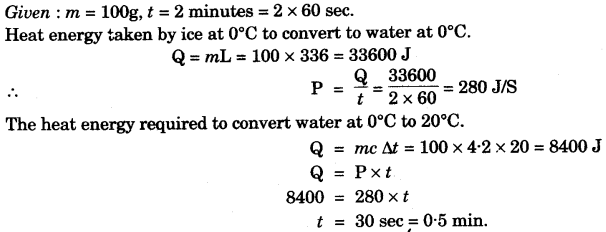
(b) (i) Substance B is a good conductor of heat.
(ii) Because specific capacity of B is less then that of A.
(iii) Substance A is more useful in car radiator.
(c) (i) Two measures to minimize the impact of global warming are :
1. Use of renewable sources of energy in place of electricity from the power generating station.
2. Use of bio-char stoves for cooking.
(ii) The green house effect is the phenomenon in which infrared radiations of long wavelength given out from the surface of a earth are absorbed by its atmospheric gases to keep the environment at the earth’s surface and the lower atmosphere, warm.
Question 10:
(a) (i) Name two factors on which the magnitude of an induced e.m.f. in the secondary coil depends.
(ii) In the following diagram an arrow shows the motion of the coil towards the bar magnet.
(1) State in which direction the current flows, A to B or B to A?
(2) Name the law used to come to the conclusion. [4]

(b) A nucleus 11Na24 emits a beta particle to change into Magnesium (Mg)
(i) Write the symbolic equation for the process.
(ii) What are numbers 24 and 11 called ? [3]
(iii) What is the general name of 12Mg24 with respect to 11Na24 ?
(c) In a cathode ray tube state :
(i) The purpose of covering cathode by thorium and carbon.
(ii) The purpose of the fluorescent screen.
(iii) How is it possible to increase the rate of emission of electrons. [3]
Answer:
(a) (i) The magnitude of induced e.m.f. in the secondary coil depends on :
(1) The change in the magnetic flux, and
(2) No. of turns in the coil.
(ii) (1) A to B (2) Lenz’s law.
(b) (i)
![]()
(ii) The number 24 is mass number and 11 is atomic number.
(iii) They are isobars.
(c) (i) The purpose of covering cathode by thorium and carbon to decrease the work function.
(ii) When electron beam on striking the screen gives a bright spot on it due to the fluorescence of the material coated on it.
(iii) On increasing the filament current, the rate of emission of electrons from the cathode will increase.
